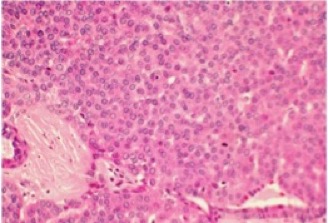The glands that produce tears are called lacrimal glands, and they are located above and to the side of the eye. Lacrimal gland cells can transform and expand out of control to produce a mass known as a tumor. A tumor may be benign or malignant. Malignant refers to the ability of a cancerous tumor to develop and spread to different body areas. If a tumor is benign, it can enlarge but will not spread.
There are different types of tumors that can start in the lacrimal gland. It is important for the doctor to find out which type it is, since this will affect the treatment plan. Types include:
A benign mixed epithelial tumor is a non-cancerous growth that does not invade surrounding tissue but will develop further if left untreated. The cells that border the lacrimal gland are where this form of tumor develops.
Malignant mixed epithelial tumor are cells that border the lacrimal gland are also where a malignant mixed epithelial tumor develops. It will spread to other bodily parts if it is not treated.
The eye’s numerous structures can be affected by lymphoma. The lacrimal glands and conjunctiva, however, are the most prevalent. The mucous membrane that lines the outside of the eye’s white and the inner surfaces of the eyelids is called the conjunctiva. Non-Hodgkin lymphoma, which most commonly affects the eyes, can be linked to central nervous system (brain and spinal cord) or systemic (whole body) cancer.
Adenocarcinoma, a general term for any cancer emerging from glandular tissues, is a rare form of cancer that affects the lacrimal gland called adenoid cystic carcinoma (AdCC). Bundles of epithelial cells that surround or infiltrate ducts or glandular structures within an organ are a characteristic pattern of an AdCC tumor. It is usual for the eye to move forward and enlarge when a lacrimal gland AdCC tumor grows. Proptosis is the name given to this disease. Another trait is pain brought on by the tumor’s impact on nearby nerves.
Vision problems, such as blurry vision, pain in or around the eye, a fullness of the eyelid, or a mass that can be felt on the eyelid, swelling around the eye and double vision are the main sign and symptoms that could be experienced by someone with a lacrimal gland tumor. There are situations when none of these symptoms are present in persons with lacrimal gland tumors. Or, these symptoms may be caused by a medical condition that is not a tumor.
Please consult your ophthalmologist if you have concerns about any of the symptoms or signs. A medical professional with a focus on eye care is known as an ophthalmologist. Along with other things, your doctor will enquire as to how long and how frequently you have been suffering the symptom. This is known as a diagnosis, and it will assist in determining the root of the issue.
If a tumor is found, managing your symptoms will still play a crucial role in your care and treatment. Symptom management, palliative care, or supportive care are other names for this. Make careful to discuss your symptoms with your medical team, particularly if they alter or develop any new symptoms.
At The Eye Center- Dr. Mahnaz Naveed Shah & Associates our team of eight ophthalmology subspecialists/ eye specialists, eye surgeons who are considered amongst the very best eye specialists in Karachi and in Pakistan, have the diagnostic and treatment capabilities to treat from the simplest to the most complex patients. We work hard to provide our patients with the best possible medical and surgical eye care, in a state of the art purpose built eye care facility. We offer the entire array of medical, laser and surgical treatments to help provide patients the best possible care in the most efficient, safe and ethical manner.
If you need an appointment, please contact us at 03041119544 during our working hours or leave us a WhatsApp message at +923028291799 and someone will connect with you. Walk-in appointments are also available for emergencies. We can also be reached through our web portal on www.surgicaleyecenter.org

